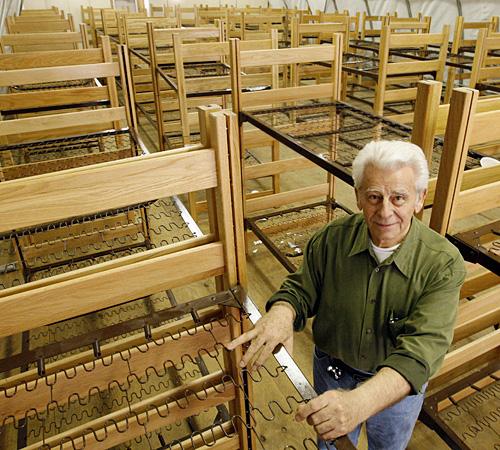Big Easy looks to put homeless in new facility

Lou Banfalvi, project director of the New Orleans Mission, poses in a 120-foot long and 30-foot wide air-conditioned tent filled with bunk beds in New Orleans, Friday. The makeshift facility is a short-term solution to what some call a homeless epidemic i The Associated Press
Feb 28, 2008
Last updated on May 12, 2016 at 10:17 p.m.
NEW ORLEANS – Since Hurricane Katrina flooded his home 30 months ago, Donald Collins said he has fled to an evacuation center, huddled in an abandoned house and lived in a tent outside City Hall.
Eventually the former sanitation worker migrated to a downtown underpass where crack sales and clothing donations seem equally common.
Mayor Ray Nagin has another stop in mind for Collins and about 200 other people who have been squatting there for months: a military-style barrack that critics say is short on long-term solutions to a homeless epidemic.
“I’m not going,” Collins, 52, said as he gulped a beer at 10:30 a.m. on a Monday, describing himself as a Katrina-inspired alcoholic on a waiting list for subsidized housing. “Something else will turn up.”
Get The Daily Illini in your inbox!
Nagin vowed to use health and safety codes to move the men and women living underneath the stretch of Interstate 10 known as the Claiborne Avenue bridge to the tarp-covered facility that was awaiting fire inspections. Aware of the camp’s proximity to the French Quarter and other tourist destinations, the mayor wants the move done by the end of the week.
The barrack, 120-feet long and 30-feet wide, is air-conditioned, filled with double-decker bunk beds and stands on the grounds of a mission in the city’s Central Business District that has worked with the homeless for 20 years.
But even its administrator said he is unsure the facility that offers only meals and overnight stays to about 120 people can really help a homeless population that has doubled to 12,000 since Katrina struck in August 2005.
“We’ll do what we can,” said Lou Banfalvi, project director at the New Orleans Mission. “We can offer them shelter. We cannot offer them a place to build a house.”
Nagin spokeswoman Ceeon Quiett said state and federal governments continue to wrap their housing assistance in red tape, while the mayor has been unfairly cast as an advocate of get-tough measures against the homeless.
The city’s public advocacy unit, unarmed officers with the New Orleans Police Department Homeless Assistance Collaborative, city housing department workers, and mission staff will usher people into the barrack as early as Thursday, Quiett said. Those who do not go elsewhere will face citations, and arrests could take place if drugs are found, city officials said.
The encampment attracted former Sen. John Edwards, who stopped there the day he ended his presidential bid and pledged to “never forget” the downtrodden.
Visiting pro athletes have handed out food there on the way to the New Orleans Arena and Louisiana Superdome a few blocks away.
Countless tourists also have passed the spectacle of curbside panhandlers, frayed camping tents, scattered sleeping bags, discarded home furnishings that stretches for about five city blocks not a half-mile from the French Quarter.
Steve Wheeler, 52, was part of a group called Homeless Pride that formed in the City Hall plaza, where 250 people lived until the pending demolition of an adjacent building prompted city officials and homeless advocates to clear the plaza.
Wheeler accused Nagin of trying “to force people back into abandoned houses, back into the business district and back into the Quarter.”
On a local morning news show last month, Nagin said his frustration with the squatters is first-person.
“I mean I pass underneath the bridge all the time, the Claiborne Avenue. Yesterday I passed there, some guy was drinking beer and just flipping the bird to citizens,” the mayor said.
The camp has grown increasingly fetid and dangerous, just like its predecessor in front of City Hall.
On Monday, a man apparently seeking to smoke crack shuffled by asking anyone who would listen, “You got a pipe? You got a pipe?” Another stormed through the grounds and pounded his hand against the tent of a rival he believed slept with his girlfriend the night before. The other man showed up later, and Collins warned him to stay away.
“I’m going to get it together and get back in a nice house,” said Collins, still working on the beer. “I won’t be on the street long.”





